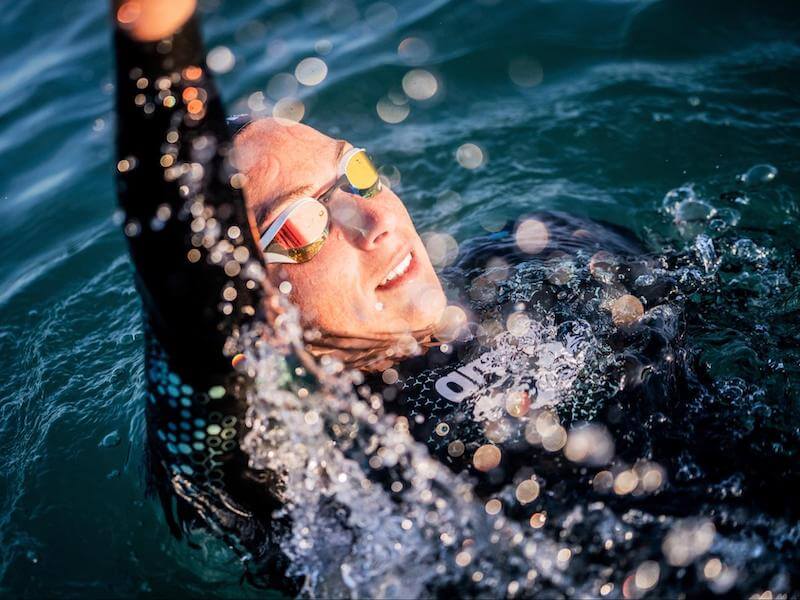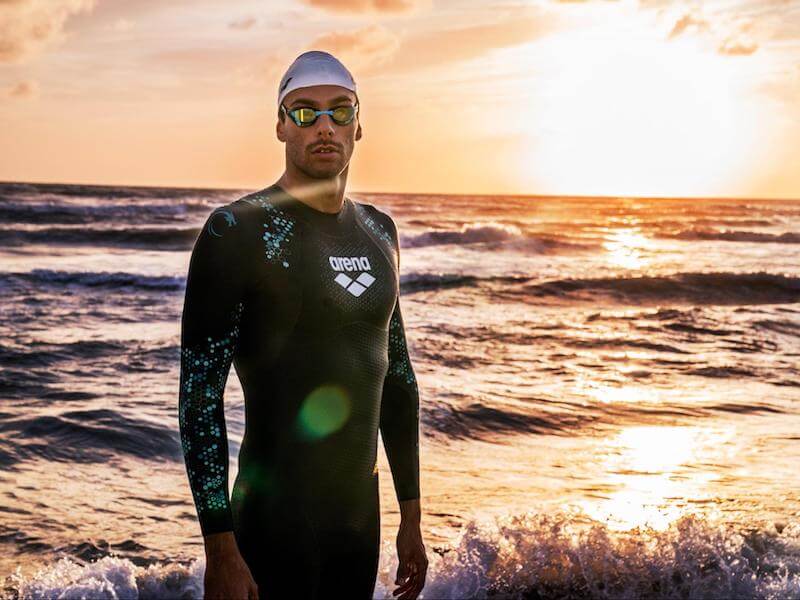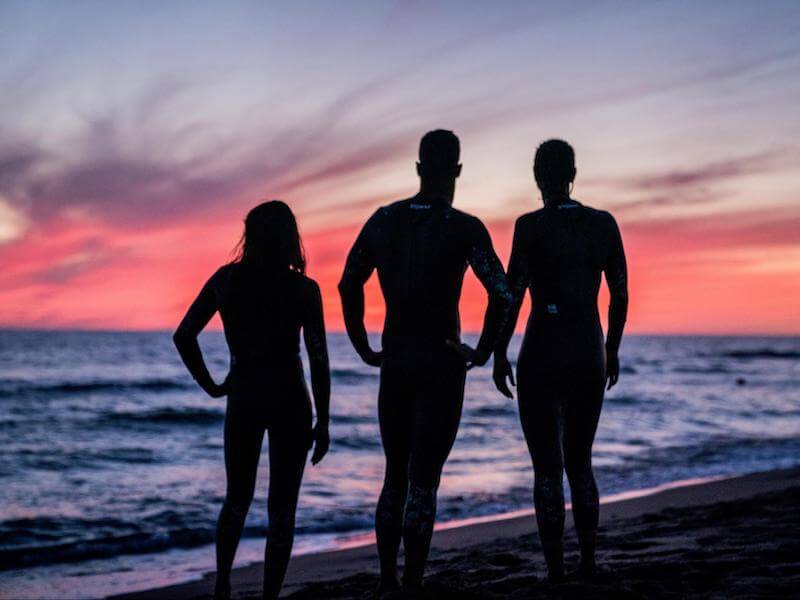What to Look For in an Open-Water Swimming Wetsuit
Open-water swimming allows you to participate in and enjoy swim training and competing in a whole new way. If you have access to lakes, ponds, or the ocean, you have almost everything you need to embrace swimming in the beauty of nature.
What more do you need? Well, these wild swimming venues can have chilly water compared to your local pool. That’s why it’s essential to select a good open-water swimming wetsuit to keep your body warm and your swim safe and enjoyable.
To get the most out of an open-water wetsuit, you’ll need to understand what these specialized suits do and how they can improve your open-water swimming experience.
We’ll point out the reasons why you should add a swimming wetsuit to your collection of gear. Then, we’ll cover how these wetsuits differ from those used in other aquatic sports. Finally, you’ll want your wetsuit to meet your needs and fit you like a second skin, so we will cover what it is you need to look for.
Top 3 Reasons to Use an Open-Water Swimming Wetsuit
There are a few reasons open-water swimmers and triathletes use wetsuits during training and competition. If you are a beginner to open-water swimming or preparing to compete in a triathlon for the first time, it is important to equip yourself with the right gear, just like it is essential to train your open-water swimming endurance. Let’s go over the top five reasons why you should wear an open-water swimming wetsuit.
1. Keeps You Warm in Cold Water
The most intuitive reason to wear a wetsuit is to trap body heat so you can stay warm while swimming in colder water. Maintaining body warmth while swimming (or performing any activity for that matter) is vital for your safety and performance levels.
When you participate in open-water swimming in large bodies of water, there is some risk involved, so it is best to keep yourself as safe as possible. The warmth from a wetsuit will keep your body temperature at normal levels, so it will continue to function normally throughout your swim. Wetsuits can protect you from becoming hypothermic and will keep your muscles warm, so you are less likely to experience cramping or extreme muscle fatigue due to the cold.
Not only does added warmth contribute to a safer swim, but it also means your body can function at its highest level of performance. Muscle function, respiration, and blood circulation will operate as they should when your body temperature stays at its normal level. Staying warm helps you get all the performance you can out of your body!
2. Adds Extra Buoyancy

Body positioning plays a huge role in swimming efficiency. The higher your body sits in the water, the less drag you will experience. More buoyancy means you’ll be able to swim faster and for longer distances with less fatigue.
A major benefit of wearing an open-water swimming wetsuit is that the neoprene construction will increase how much you float in the water. This means your whole body will be closer to the surface of the water, and you’ll find it easier to glide with each stroke you take throughout your open-water swim.
3. Reduces Drag
The density of water works against you while you swim. If you’ve ever tried swimming laps in a baggy pair of swim trunks after using a swim-specific suit, you know precisely how much well-designed swimwear can reduce drag and improve your swimming speed.
Open-water swimming wetsuits are designed with drag reduction in mind. These wetsuits often come with a special coating that will increase your glide through the water. Just like race suits, wetsuits also provide compression in key parts of the body, like the legs and midsection, to improve the hydrodynamic shape of your body.
What’s the Difference Between Swimming Wetsuits and Other Wetsuits?
There is a difference between the wetsuits used by divers, surfers, and swimmers. While all wetsuits are designed to keep you warm, they differ in other areas depending on the activity you participate in. The two main areas wetsuits differ in are the thickness and the amount of mobility. Besides these main differences, swimming wetsuits have special finishes to increase glide through the water.
Thickness is the first place to find a difference in wetsuits. Diving wetsuits can be up to 7 or 8 millimeters (mm) thick, compared to swimming wetsuits that are rarely thicker than 5 mm.
Because divers do not engage in activity that is as vigorous as swimmers do, they need thicker suits to keep themselves warm, especially if they are diving at depth. On the other hand, swimmers generate warmth while swimming, so their wetsuits do not need to be as thick.
Divers also do not need as much range of motion in the shoulders, and therefore, diving wetsuits will be thicker in that area and provide less mobility than a swimming-specific wetsuit would.
Open-water swimming wetsuits have varying neoprene thicknesses in certain parts of the body. For example, the arena Powerskin Storm Wetsuit has 1.5 mm of neoprene in the shoulders and arms, 3 mm in the chest, upper back, and lower legs, and 4 mm in the midsection. The distribution of thickness provides adequate buoyancy without sacrificing range of motion.
Surfing wetsuits and diving wetsuits lack the special outer coatings that swimming wetsuits have. As mentioned above, these coatings work to improve your glide through the water.
What to Look For in an Open-Water Swimming Wetsuit

Choosing the best wetsuit for your needs depends on a few things. The best wetsuit for you will do everything from keeping you warm to increasing your buoyancy levels while maintaining your range of motion. Let’s cover what you need to look for when deciding on a new wetsuit.
As we mentioned above, search for a wetsuit with varying neoprene thicknesses. Generally, the neoprene should be thinner in the arms and shoulders to provide an adequate range of motion. It should be thicker in the mid-section of the body to keep you warm and provide increased buoyancy.
High-quality neoprene, like the Yamamoto 39 and Yamamoto 40 neoprene used in the arena Powerskin Storm Wetsuit, will improve your range of motion, and it will be more comfortable to wear. Plus, the more flexible neoprene will make changing in and out of the suit easier. Another thing to consider is how eco-friendly the neoprene is.
Also, look for wetsuits that have features like collars that reduce chafing and ankle and wrist cuffs with thinner neoprene thicknesses to help you get the wetsuit on and off.
Finally, you’ll have to decide between a wetsuit with or without sleeves. Wetsuits with sleeves will be warmer and more buoyant than their sleeveless counterparts. Sleeveless wetsuits will provide a more natural feel in your swim stroke. If you swim in cold water, consider a sleeved wetsuit. If the water you swim in is not too cold and you prefer more mobility, then go for a sleeveless suit.
How Should Your Open-Water Swimming Wetsuit Fit?
Now that you know what to look for in a wetsuit, it is important to understand how it should fit.
Watch out for a wetsuit that is too tight. You’ll feel that you have a minimal range of motion in a wetsuit that is too small for you. This will impact your ability to swim with proper form.
A wetsuit that is too large also leads to complications. The wetsuit will bunch up, and you might experience chafing as the wetsuit moves against your skin. This will also affect your swim.
A wetsuit that fits just right should hug your body without feeling overly tight. There should not be any baggy or loose spots on the suit, especially around your arms and shoulders.
Once you have the wetsuit on, try running through some arm stretches to see if you have a good range of motion. If it seems difficult to do this, the wetsuit may be too tight. If you feel a lot of looseness in the suit or it rubs against your skin, it may be too large.
A Good Wetsuit is Key for Open-Water Swimming

A quality open-water swimming wetsuit is an essential piece of swimwear for entry-level swimmers and seasoned triathletes alike, especially when water temperatures are low. Your wetsuit will keep you warm and buoyant. It will also help you glide through the water. Choosing a swimming-specific wetsuit that fits well and is constructed with quality neoprene will make your open-water swim enjoyable time and time again.
All you need is a swim cap, open-water swimming goggles, and a great wetsuit to start your journey. Take a look at arena’s entire line of men’s wetsuits and women’s wetsuits.
Written by:
Harrison Howarth
Harrison is a freelance writer with a background in competitive aquatic sports. His love for water polo and swim, combined with his passion for writing and education, drives him to continue teaching and inspiring individuals to participate in aquatics.







